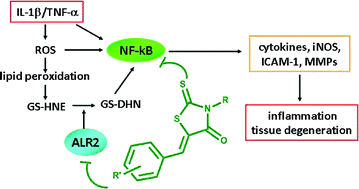(5-Arylidene-4-oxo-2-thioxothiazolidin-3-yl)acetic acids (6) and 5-arylidene-4-oxo-2-thioxothiazolidines (7), which we recently synthesised and assayed as aldose reductase inhibitors, were evaluated as anti-inflammatory/antidegenerative agents in cultures of human chondrocytes stimulated by IL-1β. In this screening, most of the tested compounds were able to control key components of the IL-1β-induced inflammatory signalling, by reducing the levels of NF-kB, ICAM-1, and NO as well as increasing the production of glycosaminoglycans by chondrocytes. Moreover, these 4-thiazolidinone derivatives exhibited antioxidant properties and were shown to inhibit MMP-3 and MMP-13 at micromolar concentrations, with a generally marked preference toward MMP-13 which plays a major role in cartilage degeneration. Thus, on the whole, compounds 6 and 7 were shown to be capable of both counteracting inflammatory events and contributing to restore normal levels of cartilage components. This anti-inflammatory/antidegenerative profile makes them interesting cell-permeable molecules that can be assumed as lead compounds in the search for novel anti-inflammatory agents.

You have access to this article
 Please wait while we load your content...
Something went wrong. Try again?
Please wait while we load your content...
Something went wrong. Try again?


 Please wait while we load your content...
Please wait while we load your content...